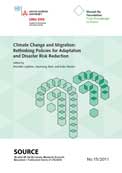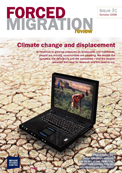Posted by Kayly Ober on August 25th, 2011 | 

In 2010, UNU-EHS and the MunichRe Foundation held a Summer Academy on “Protecting Environmental Migrants: Creating New Policy and Institutional Framework”, which aimed to develop policy options for decision makers to better address the needs of environmentally-induced migrants. The issue “Climate Change and Migration: Rethinking Policies for Adaptation and Disaster Risk Reduction” presents the outcomes of that Summer Academy and the selected
papers of PhD students from different academic backgrounds. These papers cover various aspects of the complexity of protection issues for environmental migrants and analysis of current protection regimes.
Using case studies conducted in both developing and developed countries, these papers identified legal and institutional gaps and explored possible policy options for decision makers.
Table of Contents
Section One: Improving National Governance and Regional Cooperation in Managing Displacement and Migration: Selected Case Studies
Rapid-Onset Disasters
- “Vulnerability and Population Displacements due to Climate-Induced Disasters in Coastal Bangladesh” by Dulal Chandra Roy
- “Community Resilience and Hurricane Ida: How Marginalized Salvadorans Lacking NGO and Governmental Support Cope with Climate Shock” by Elizabeth Tellman
- “United States Environmental Migration:Vulnerability, Resilience, and Policy Options for Internally Displaced Persons” by Michelle A. Meyer Lueck
Slow-Onset Disasters
Section Two: Improving International Law and Regional Cooperation on Migration to Enhance Development and Climate Change Adaptation: Selected Case Studies
- “Regional Labour Migration as Adaptation to Climate Change?: Options in the Pacific” by Fanny Thornton
- “Temporary Labour Migration for Victims of Natural Disasters: The Case of Columbia [sic]” by Nicole de Moor
- “Climate Change and Institutional Change in UNHCR” by Nina Hall
Read the full issue here.
Posted by Kayly Ober on August 22nd, 2011 | 
Two new publications will be coming out in September 2011 on climate change and migration. (H/T
Forced Migration Current Awareness)
Climate Change and Migration: Security and Borders in a Warming World (OUP, Sept. 2011) [info]
“Focusing on climate-induced migration from Africa to Europe, [Gregory] White shows how global warming’s impact on international relations has been significant, enhancing the security regimes in not only the advanced economies of the North Atlantic, but in the states that serve as transit points between the most advanced and most desperate nations. Furthermore, he demonstrates that climate change has altered the way the nations involved view their own
sovereignty,
as tightening or defining borders in both Europe and North Africa leads to an increase of the state’s reaches over society.”
The Oxford Handbook of Climate Change and Society (OUP, Sept. 2011) [info]
Included is the chapter “Climate Refugees and Security: Conceptualizations, Categories, and Contestations,” in which the authors “question the validity of the climate refugee category, arguing that far from providing succor and solace to the most vulnerable communities within the global South, the climate refugee is asubject of securitization. The most dominant perspective remains a realist (state-centric), militarist narrative, and the climate refugee is constructed, at best, as a victim of a global polity with no human agency–a political entity outside sovereignty–or, even worse, as an environmental criminal or terrorist” (p. 279).
Posted by Kayly Ober on August 16th, 2011 | 
(Inter Press Service) August 16, 2011 – As the effects of accelerating climate change ripple outward, pushing millions from their land and homes, experts warn that international human rights and refugee law needs to catch up to the reality on the ground if migrants are to be given adequate protection and support.
The 1998 Guiding Principles on Internal Displacementcould serve as an interim model “until a more comprehensive solution is found”, says Jane McAdam, director of the International Refugee and Migration Law project at the Gilbert and Tobin Centre of Public Law, University of New South Wales, Australia.
“At the moment, if somebody crosses the border and says ‘I need protection, I fled the impacts of climate change’, there is no mechanism to provide that,” she explained.
Seeing the big picture of how climate change impacts on people’s livelihoods and their decision to migrate as an adaptation strategy is indispensable, McAdam stressed.
“Climate change overlays preexisting stressors that people face and it is about taking a multi-pronged approach to solutions at every level, from the sub-national through to the national, to the regional and international,” she said.
McAdam spoke to IPS U.N. correspondent Rousbeh Legatis about the pros and cons of the Guiding Principles on Internal Displacement for devising a further legal framework to protect climate-driven migrants worldwide.
Excerpts from the interview follow.
Continue reading this post »
Posted by Kayly Ober on August 11th, 2011 | 
(Inter Press Service) August 11, 2011 – With political will to dramatically cut the world’s greenhouse gas emissions failing to materialise, a multi-pronged approach is needed to protect the millions of people who are being displaced as a result of environmental factors driven largely by climate change, experts say.
“Climate change is looming as a potentially very serious and underappreciated complicating factor when it comes to international displacement,” said Erika Feller, the assistant high commissioner for protection in the office of the U.N. High Commissioner for Refugees.
More is needed from the international community to address this challenge “in a coordinated and pragmatic manner”, she told IPS.
Of paramount importance is that national authorities play a central role in developing appropriate responses to both the internal and external dimensions of climate-related displacement, while affected persons and communities must be made fully aware of their rights and given opportunities to participate in decision-making, Feller said.
“Decisions about where, when and how to relocate communities, for example, must be made in consultation with the affected populations and be sensitive to cultural and ethnic identities and boundaries to avoid possible tensions and conflicts,” she added.
Continue reading this post »
Posted by Kayly Ober on August 1st, 2011 | 
(AlertNet) August 1, 2011 – The political turmoils in Syria, along with Egypt and other countries in the Middle East, have entangled the international community and served as a major test of global governance.
Syria’s political difficulties have lead to such problems as a stream of refugees fleeing to the Turkish border, exacerbated sectarian tensions and contributed to the deterioration of human rights in the region, according to the United Nations High Commissioner for Human Rights.
And new stories about regional security and humanitarian troubles in Syria have been emerging, despite the Syrian government’s intensive media blockade. But what rarely gets commented upon is the devastating drought that has gripped Syria since 2006 and reportedly driven more than 1.5 million people from the countryside to cities in search for food and economic normality.
Compounding the problem are the country’s so-called market reforms that have resulted in cutbacks in subsidies for food and fuel. Even as the political future of Syria and its President Bashar al-Assad remain uncertain, what is arguably a source of greater political instability in the long-term are the problems associated with drought and resource scarcity-induced migration that show no signs of abating.
Continue reading this post »
Posted by Kayly Ober on July 21st, 2011 | 
The United Nations Resident and Humanitarian Coordinator’s Office of Nepal released a field bulletin about the long-term disaster displacement in the country.
Almost all districts across the Far West face losses of lives and proper
ty every year due to natural disasters. However, the impact can last well beyond the immediate event. Humanitarian actors have observed that the duration of displacement varies depending on the intensity and type of disaster: displacement following inundation of rivers is generally short term, while displacement resulting
> from floods and erosion is generally longer term.
Read the brief
in full here.
|
|




